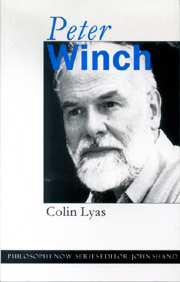Book contents
- Frontmatter
- Contents
- Preface
- Introduction: Peter Winch, a glimpse of a life
- 1 “Such understanding as I have”: The influence of Wittgenstein
- 2 “I was investigating the notion of the social”: The idea of a social science
- 3 “Seriously to study another way of life”: Understanding another society
- 4 “Good examples are indispensable”: The ethical life
- 5 “The concept of God is used”: The religious forms of life
- 6 “The interval of hesitation”: Peter Winch's Simone Weil
- 7 “Someone willing to die for truth”: Peter Winch's legacy
- Envoi
- References
- Index
6 - “The interval of hesitation”: Peter Winch's Simone Weil
- Frontmatter
- Contents
- Preface
- Introduction: Peter Winch, a glimpse of a life
- 1 “Such understanding as I have”: The influence of Wittgenstein
- 2 “I was investigating the notion of the social”: The idea of a social science
- 3 “Seriously to study another way of life”: Understanding another society
- 4 “Good examples are indispensable”: The ethical life
- 5 “The concept of God is used”: The religious forms of life
- 6 “The interval of hesitation”: Peter Winch's Simone Weil
- 7 “Someone willing to die for truth”: Peter Winch's legacy
- Envoi
- References
- Index
Summary
Simone Weil
For those who do not know of the life and work of this remarkable woman I begin with an imagined description of her thoughts during her last moments in the sanatorium in which she died, in 1943, in Ashford, Kent:
Tuesday 24 August was a warm summer's day. As Simone Weil lay in her bed, her mind moved beyond the distant hills. She saw again the Paris in which she grew up, the cafes of the Boulevard St. Michel, her paper strewn room in the spacious flat of the rue Auguste Comte, with its view over Paris as far as Sacre Coeur, at the Lycée Henri IV where she listened to the thoughts of Alain, and the École Normale with its passionate political commitments. She saw again her school in quiet Le Puy, her little class in the summer house at Roanne, and the workers of St. Etienne with their red flag. She saw again the grinding factories of Alsthom and Renault, the miserable little room in the rue Lecourbe, and the joyful days of the Popular Front. She saw the Abbey of Solesmes besides its quiet river and heard the Gregorian chant. She saw the flat in Marseilles with the sound of the sea and the cries from the beach coming in through the open windows. … She saw New York and the Hudson River and her anxious waiting parents. She saw London with its parks, its pubs, its telegrams and its anger. And she saw Ashford with its green trees and green fields on which the sun was declining. At half past ten her heart stopped beating and she died.
(McLellan 1989: p. 266)- Type
- Chapter
- Information
- Peter Winch , pp. 155 - 180Publisher: Acumen PublishingPrint publication year: 1999



